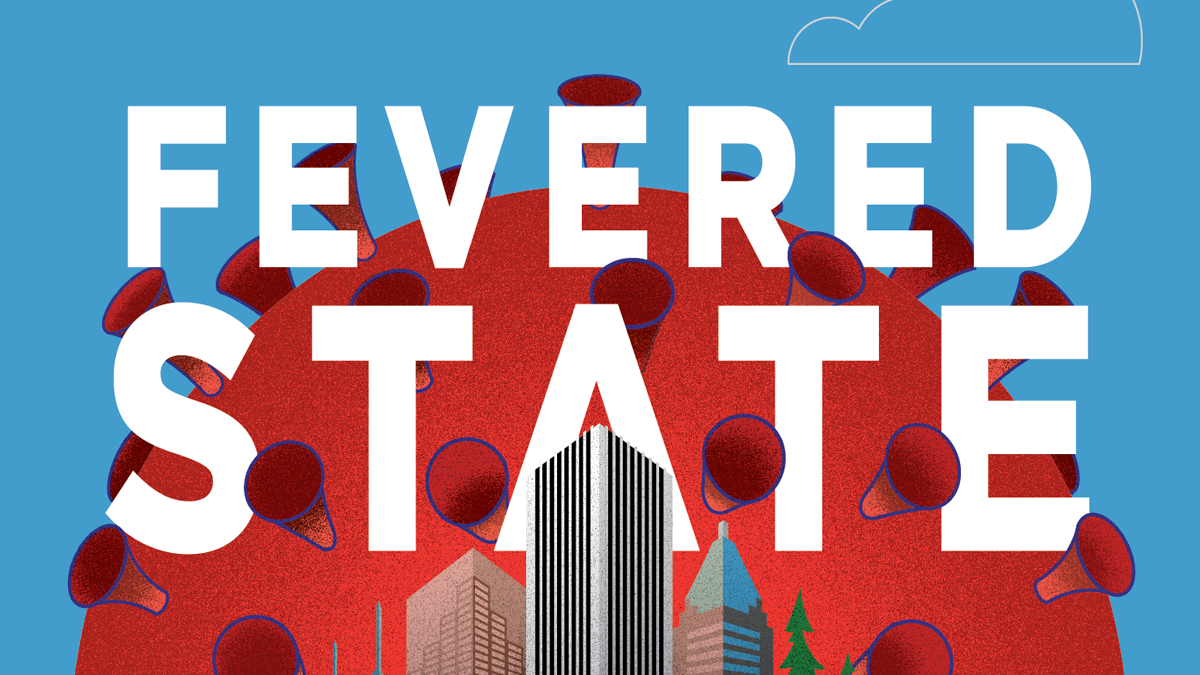Oregon is a state choked by COVID-19.
Since July 1, the state has seen 3,800 new cases of the virus, more infections than in the entire month of May. According to a variety of experts, the gradual resumption of economic and social routines in this state is responsible for the virus's swift resurgence, from Portland to Pendleton.
"Economics is driving some of the risk we are exposing people to," says Carlos Crespo, vice provost at Portland State University and a professor of public health. "When we increased the speed limit from 55 to 65, we could tell you exactly how many people were going to die in car accidents. We did that for economic reasons."
One month after Gov. Kate Brown lifted the lockdown, health watchdogs are demanding she shut down the state again.
"You don't need to be an epidemiologist to recognize that things are getting worse," says Multnomah County Commissioner Sharon Meieran. "The writing is on the wall. The governor will [eventually] close bars and indoor restaurants, but the delay in doing the inevitable will only make things worse. It's not a hard decision, it's just not being made."
Brown has not taken that advice. Instead, this week she took incremental steps: She required masks be worn outdoors, and she banned house parties of 10 people or more.
On July 13, Brown acknowledged that Oregon is poised on the brink. "Today we are sounding the alarm because we are at risk of letting the virus spiral out of control," she said. "The question now is whether Oregon will be the next New York or the next Texas."
She was referring to the two capitals of the disease: New York, which led the nation in deaths two months ago but has since fought the virus to a draw, and Texas, where hospitals are now overwhelmed.
Yet many citizens remain convinced Brown is overreacting. They think masks are for cowards, and the governor is a tyrant.

To grasp how precarious this moment is for Oregon, we took a look at how it ranks among other U.S. states in a catastrophic year.
We compared Oregon to other states on testing, hospitalizations, deaths, case counts, and bar and restaurant reopenings.
We found that Oregon is neither the nation's strictest state, nor the most foolhardy. In some ways, we've been cautious. In others, Brown hasn't made the tough decisions that could prevent wider spread of the disease.
In fact, what the comparison shows is this: So far, Oregon has been pretty lucky.
Our death rate is low, and our rise in cases doesn't match that in other places. But our stability is fragile. We don't have the capacity in tests and ICU beds to keep up with a spike that our rules aren't guaranteed to prevent.
"I think it's a mix of luck and having good policy to some extent, in that we had a fast response early," says Numi Lee Griffith, a health care advocate with the public interest group OSPIRG. "I think that's a big part of why we haven't been hit that hard so far—even though we're next to Washington and California, which have both had relatively severe outbreaks."
"Overall, as a state, we are doing OK," she added. "But some of the rural counties are getting hit really, really badly already."
Back in February, Americans living in Florence, Italy, warned that the virus was rapidly killing people, and begged this nation to avoid a similar fate.
If Italy was a warning to America, now America is a warning to Oregon.
In the following pages, we'll show you where we stand—and how we could fall into disaster.

Policies
The COVID-19 crisis is framed by politics, to state the obvious. President Donald Trump turned mask-wearing into a culture war and has spoken dismissively of a disease that has in four months killed 133,000 Americans—nearly triple U.S. deaths in the Vietnam War—and 244 Oregonians. The lack of federal leadership has resulted in a patchwork of policies to stem the virus's spread. Oregon is neither the strictest state, nor the most lax.
Where are masks required?
Until July 13, Oregon was the only state on the West Coast without a mask requirement in all public spaces, indoors and out. This week, Gov. Kate Brown changed that: Anywhere people can't stay 6 feet apart from each other, they must mask up. Brown's latest mask policy, while significant, still isn't the strictest in the country.

Where are restaurants and bars open?
Few places are as conducive to the spread of COVID-19 as bars and restaurants. In most states, dine-in eateries and watering holes are among the last establishments to reopen. Gov. Brown kept such businesses closed longer in Portland than in other Oregon cities. Now both bars and restaurants are open statewide, albeit with shortened hours. This month, many U.S. states have acknowledged that opening bars was a mistake—and shut them down again. The most recent? California, which issued another last call July 13.

How long were restaurant dining rooms closed?
In March, most U.S. cities locked down in rapid succession as the virus arrived on our shores. But many cities and states reopened swiftly—seeking to jump-start their economies at the encouragement of the president. Oregon was more cautious: Gov. Brown reopened the state gradually, making Portland go last. Here's how Portland's timeline compares to those of other, similarly sized cities.


Results
Oregon has largely escaped the most horrifying outcomes of the coronavirus. That probably reflects a combination of policy success and dumb luck. The state has less international travel than other early U.S. hot spots, didn't have any super-spreader outbreaks, and shut down early.
How deadly has COVID-19 been in Oregon?
Oregon has so far experienced a low COVID-19 death rate by U.S. standards. Per capita, Oregon has the sixth-lowest death rate in the nation.

How fast are cases rising in each state?
A nationwide rise in cases is what most alarms elected officials and public health experts. Oregon is seeing a steep increase—but it pales in comparison to the spikes in Texas, Florida and California. In fact, Oregon is seeing cases rise more slowly than any of the states along its border.


How do Oregon's rural outbreaks compare to America's hot spots?
Oregon's status looks less rosy when you look at its rural counties. As elsewhere, Oregon's hot spots first sprang up in cities, but cases are now much more prevalent in the countryside. That's thanks in part to COVID denial, and outbreaks at food processing plants and state prisons. In fact, over the past two weeks, as of July 11, some of Oregon's rural counties are getting sick at a rate that surpasses that of the hardest-hit states in the nation.


Outlook
While Oregon has fared better than many states in the first stage of the pandemic, its prognosis isn't terrific. The state has little testing capacity and even fewer hospital beds. That leaves little margin for error as Gov. Brown weighs her next big decision: whether children should return to classrooms this fall.
How many people are getting COVID tests?
Oregon has consistently tested for COVID-19 less than other states, in part because this state's modest case counts make it a low federal priority. That's a problem because testing is the first step in figuring out where the virus has taken hold, so health officials can stop a few cases from exploding into a widespread outbreak. Oregon officials project testing-supply shortages will get worse as other states experience dramatic spikes. That could leave Oregon incapable of determining who is sick—which is one of the few ways to keep the disease from spreading, short of sending everyone home again.

How many hospital beds are occupied?
Oregon has the lowest per capita number of acute care beds of any state in the country. That now creates a complication if the pandemic takes hold in Oregon. So far, the number of people getting severely ill hasn't outstripped hospital
capacity. Even so, Oregon's few cases have filled hospitals nearly as much as those in states with far more people falling ill.

Will kids go back to school this fall?
The Trump administration is again politicizing the pandemic with its push for fact-free school reopenings. That leaves school districts to decide whether they should let children return to classrooms in the fall. Some districts have already pivoted to video. (All these districts will have an option for students not to attend school in person. That could mean everything from computer games to Zoom classes.) It's the next decisive point in the pandemic—and many districts, including Portland, concede their plans are fluid.



